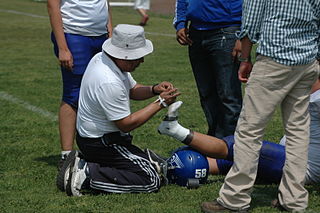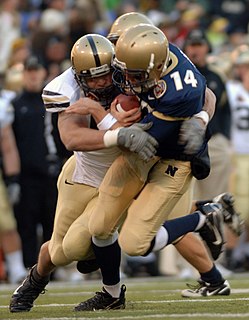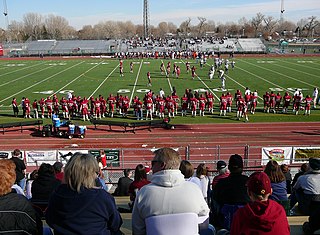Related Research Articles

Sports injuries are injuries that occur during sport, athletic activities, or exercising. In the United States, there are approximately 30 million teenagers and children combined who participate in some form of organized sport. Of those, about three million athletes age 14 years and under experience a sports injury annually. According to a study performed at Stanford University, 21 percent of the injuries observed in elite college athletes caused the athlete to miss at least one day of sport, and approximately 77 percent of these injuries involved the lower leg, ankle, or foot. In addition to those sport injuries, the leading cause of death related to sports injuries is traumatic head or neck occurrences. When an athlete complains of pain or an injury, the key to a diagnosis is to obtain a detailed history and examination. An example of a format used to guide an examination and treatment plan is a S.O.A.P note or, subjective, objective, assessment, plan. Another important aspect of sport injury is prevention, which helps to reduce potential sport injuries. It is important to establish sport-specific dynamic warm-ups, stretching, and exercises that can help prevent injuries common to each individual sport. Creating an injury prevention program also includes education on hydration, nutrition, monitoring team members “at risk”, monitoring at-risk behaviors, and improving technique. Season analysis reviews, preseason screenings, and pre-participation examinations are also essential in recognizing pre-existing conditions or previous injuries that could cause further illness or injury. One technique that can be used in the process of preseason screening is the functional movement screen. The functional movement screen can assess movement patterns in athletes in order to find players who are at risk of certain injuries. In addition, prevention for adolescent athletes should be considered and may need to be applied differently than adult athletes. Lastly, following various research about sport injury, it is shown that levels of anxiety, stress, and depression are elevated when an athlete experiences an injury depending on the type and severity of the injury.

A concussion, also known as a mild traumatic brain injury (mTBI), is a head injury that temporarily affects brain functioning. Symptoms may include loss of consciousness (LOC); memory loss; headaches; difficulty with thinking, concentration or balance; nausea; blurred vision; sleep disturbances; and mood changes. Any of these symptoms may begin immediately, or appear days after the injury. Concussion should be suspected if a person indirectly or directly hits their head and experiences any of the symptoms of concussion. It is not unusual for symptoms to last 2 weeks in adults and 4 weeks in children. Fewer than 10% of sports-related concussions among children are associated with loss of consciousness.

Sports medicine is a branch of medicine that deals with physical fitness and the treatment and prevention of injuries related to sports and exercise. Although most sports teams have employed team physicians for many years, it is only since the late 20th century that sports medicine has emerged as a distinct field of health care. In some countries, Sports medicine is a recognized medical specialty, whereas in other countries it is a special interest area but not an actual specialty.
Athletic training has been recognized by the American Medical Association (AMA) as an allied health care profession since June 1991.
"Athletic training is practiced by athletic trainers, health care professionals who collaborate with physicians to optimize activity and participation of patients and clients. Athletic training encompasses the prevention, diagnosis, and intervention of emergency, acute and chronic medical conditions involving impairment, functional limitations and disabilities."

The football helmet is a piece of protective equipment used mainly in gridiron football. It consists of a hard plastic shell with thick padding on the inside, a face mask made of one or more plastic-coated metal bars, and a chinstrap. Each position has a different type of face mask to balance protection and visibility, and some players add polycarbonate visors to their helmets, which are used to protect their eyes from glare and impacts. Helmets are a requirement at all levels of organized football, except for non-tackle variations such as flag football. Although they are protective, players can and do still suffer head injuries such as concussions.

Health issues in American football comprise a large number of health risks associated with participating in the sport. Injuries are relatively common in American football, due to its nature as a full-contact game. Injuries occur during both practice and games. Several factors can affect the frequency of injuries: epidemiological studies have shown older players can be at a greater risk, while equipment and experienced coaches can reduce the risk of injury. Common injuries include strains, sprains, fractures, dislocations, and concussions. Concussions have become a concern, as they increase the risk of mental illnesses like dementia and chronic traumatic encephalopathy (CTE). In individual leagues like the National Football League (NFL) and National Collegiate Athletic Association (NCAA), a public injury report is published containing all injured players on a team, their injury and the game-day status of each player.
Toi Fitzgerald Cook is a former professional American football player who was selected by the New Orleans Saints in the eighth round of the 1987 NFL Draft. A 5'11", 188 lb (85 kg). defensive back from Stanford University, he played in 11 NFL seasons from 1987 to 1997. In 1992, he had a career-high six interceptions for 90 yards and one touchdown for the Saints. He appeared in Super Bowl XXIX for the victorious San Francisco 49ers. He had an interception in the Super Bowl. Before his NFL career, he was an outfielder, and the leadoff hitter, on Stanford's 1987 College World Series national champion baseball team.

USA Football is the national governing body for amateur American football in the United States. It is an independent non-profit based in Indianapolis, Indiana. USA Football designs and delivers premier educational, developmental and competitive programs to advance, unify and grow the sport. As the sport’s national governing body, member of the U.S. Olympic & Paralympic Committee and organizer of the U.S. National Team for international competition, USA Football partners with leaders in medicine, child advocacy and athletics to support positive football experiences for youth, high school and other amateur players.
Sports law in the United States overlaps substantially with labor law, contract law, competition or antitrust law, and tort law. Issues like defamation and privacy rights are also integral aspects of sports law. This area of law was established as a separate and important entity only a few decades ago, coinciding with the rise of player-agents and increased media scrutiny of sports law topics.
Second-impact syndrome (SIS) occurs when the brain swells rapidly, and catastrophically, after a person suffers a second concussion before symptoms from an earlier one have subsided. This second blow may occur minutes, days or weeks after an initial concussion, and even the mildest grade of concussion can lead to Second impact syndrome. The condition is often fatal, and almost everyone who is not killed is severely disabled. The cause of SIS is uncertain, but it is thought that the brain's arterioles lose their ability to regulate their diameter, and therefore lose control over cerebral blood flow, causing massive cerebral edema.

The health issues of youth sports are concerns regarding the health and wellbeing of young people between the ages of 6 and 18 who participate in an organized sport. Given that these athletes are physically and mentally underdeveloped, they are particularly susceptible to heat illness, eating disorders and injury; sufficiently severe conditions can result in death. Awareness and prevention are key factors in preventing many health issues in youth sports.

Helmet-to-helmet collisions are occurrences in gridiron football when two players' helmets make head-to-head contact with a high degree of force. Intentionally causing a helmet-to-helmet collision is a penalty in most football leagues, including many high school leagues.

Prevention of mild traumatic brain injury involves taking general measures to prevent traumatic brain injury, such as wearing seat belts and using airbags in cars. Older people are encouraged to try to prevent falls, for example by keeping floors free of clutter and wearing thin, flat, shoes with hard soles that do not interfere with balance.
Concussions and other types of repetitive play-related head blows in American football have been shown to be the cause of chronic traumatic encephalopathy (CTE), which has led to player deaths and other debilitating symptoms after retirement, including memory loss, depression, anxiety, headaches, stress, and sleep disturbances.

Schutt Sports was a United States company that manufactured protective gear for several sports, focusing on American football, baseball, softball, and lacrosse. Products manufactured by company, headquartered in Litchfield, Illinois, included helmets and other protections such as jockstraps, and shoulder pads. The company also produced American football sportswear including jerseys and pants.
Concussions, a type of mild traumatic brain injury, are a frequent concern for those playing sports, from children and teenagers to professional athletes. Repeated concussions are a known cause of various neurological disorders, most notably chronic traumatic encephalopathy (CTE), which in professional athletes has led to premature retirement, erratic behavior and even suicide. In the context of sports-related concussions (SRC), an SRC is currently defined as a "complex pathophysiological process affecting the brain, induced by biomechanical forces". Because concussions cannot be seen on X-rays or CT scans, attempts to prevent concussions have been difficult.
The National Operating Committee on Standards for Athletic Equipment (NOCSAE) is a non-profit organization operating in the United States, whose mission is to reduce athletic injuries and death through standards and certification for athletic equipment. Schools and universities look to NOCSAE certification of equipment, particularly helmets, to protect players and reduce liability. NOCSAE data indicate a significant reduction in athlete fatalities and brain injuries when using NOCSAE-certified equipment. NOCSAE has been criticized for stifling innovation, holding a conflict of interest, and not furthering true player safety.
A catastrophic injury is a severe injury to the spine, spinal cord, or brain, and may also include skull or spinal fractures. This is a subset of the definition for the legal term catastrophic injury, which is based on the definition used by the American Medical Association.
Axon Sports, LLC produces cognitive training products for athletes. These tools are intended to accelerate skill acquisition and develop cognitive skills for success on the field of play. Axon Sports’ training products have been adopted by professional teams, prominent USA NCAA Division I athletic departments and elite high performance training centers in both the United States and the United Kingdom.
Mark John Aubry is a Canadian physician and sports medicine specialist. He is the team physician for the Ottawa Senators, and serves as the Chief Medical Officer of both the International Ice Hockey Federation, and Hockey Canada. He researches and lectures on concussions, plays a leadership role for safety in sport, and is an injury prevention activist in minor ice hockey. He is a recipient of the Paul Loicq Award for his international work, and the Dr. Tom Pashby sports safety award for Canada.
References
- Jane E. Brody, Winning Is Good, but Playing Safely Is Better, New York Times, October 19, 2004
- https://web.archive.org/web/20080304124611/http://www.safetycenter.navy.mil/toolbox/sports/outdoor/default.htm
- http://www.mlb.com/usa_baseball/article.jsp?story=medsafety17
- http://www.sportssafety.org
- Fred Bowen, What You Don't Know Might Hurt You, The Washington Post, Friday, March 7, 2008; Page C12
- Kelly McClurg, HealthSouth's Lemak heads sports safety push, Birmingham Business Journal, 21 December 2001
- New online safety course for coaches launched by National Center for Sports Safety and the National Athletic Trainers' Association, The Journal of Physical Education, Recreation & Dance, August, 2004